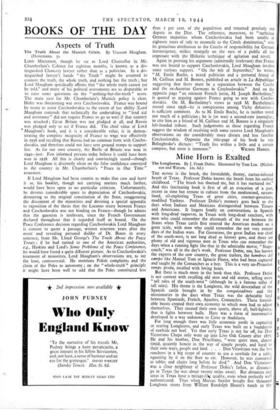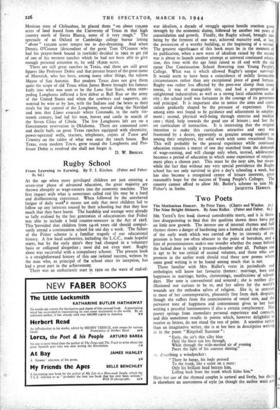Mine Horn is Exalted
THE monte is the brush, the formidable, thorny, cactus-infested brush of Texas. Professor Dobie knows the brush from his earliest childhood. "The brush has thorned me, but it has nurtured me." And this fascinating book is first of all an evocation of a past, recent in time but remote in culture from the modernised, stream- lined, oil-exploiting Texas of great cities, crooner-governors, modified Yankees. Professor Dobie's memory goes back to the days when Indians and Mexicans distinguished between Texans and Americans. It lingers fondly on conversations in Spanish with long-dead vaqueros, in Texan with long-dead ranchers, with men who could remember the aftermath of the war between the States when Texas cattle first entered the American market on a great scale, with men who could remember the not very remote days of the Indian wars. For Geronimo, the great Indian war chief of the south-west, is not long dead as history goes, and there are plenty of old and vigorous men in Texas who can remember the days when a running fight like that in the admirable movie, "Stage- coach," was all in the day's work. Professor Dobie, too, has known the experts of the cow country, the great trailers, the hombres del campo like Manuel Tom or Ignacio Flores, who had been captured and taught by the Comanches as a boy. This is a very un-Proustian temps perdu, recalled with loving heart. But there is much more in the book than this. Professor Dobie is not content with recalling old men and old stories, telling more "tall tales of the south-west" (although he is a famous teller ot tall tales). His theme is the Longhorn, the wild descendant of the Spanish cattle brought in by the conquistadores and the missionaries in the days when Texas was the debatable land between Spaniards, French, Apaches, Comanches. These formid- able beasts created their own economy to which men had to adjust themselves. They created their own sports, above all, bull-fighting, that is fights between bulls. Here was a form of tauromachia developed in a way unknown to Crete or Andalusia.
For long enough there was little economic profit in capturing or rearing Longhorns, and early Texas was built on a foundation of rawhide not beef. Yet that early Texas is not far off, for Don Victoriano Chapa only went up into Live Oak County after 1876. He and his brother, Don Prisciliano, "were quiet men, almost timid, quaintly honest in the way of simple people, and loyal to their own ways, people and land. . . . Don Victorian° was the last ranchero in a big scope of country to use a cowhide for a table, squatting by it on the floor to eat. However, he was converted to tables and chairs long before he died." And Don Victorian° was a close neighbour of Professor Dobie's father, as distances go in Texas (he was about twenty miles away). But distances and areas in Texas have 'a mirage-EV quality, even when perfectly well authenticated. Thus when Marcus Snyder bought five thousand Longhorn steers from Wham Randolph Hearst's ranch in the Mexican state of Chihuahua, he placed them "on about 15o,000 acres of land leased from the University of Texas in that high country north of Sierra Blanca, some of it very rough." The spectacle of an Oxford or Cambridge college bursar letting "about" 150,000 acres tempts me to day-dreaming. And when Dennis O'Connor (descendant of the great Tom O'Connor who had his prayer-book bound in rawhide) decided in 1902 to get rid of one of his western ranches which he had not been able to give enough personal attention to, he sold 58,000 acres.
There are still great ranches in Texas, and there are still great figures like Professor Dobie and that present bearer of the great name of Maverick, who has been, among many other things, the reform Mayor of San Antonio. But modern Texas does not give them quite the scope of old Texas when James Bowie brought his famous knife into what was soon to be the Lone Star State, when stam- peding Longhorns inflicted a first defeat at Bull Run on the army of the United States and when the cowboys and vaqueros, un- worried by wire or by law, with the Indians and the bears as their rivals for the control of the Longhorns, moved along the Navidad and into that Llano estacado where Coronado, in the early six- teenth century, had led his men, horses and cattle in search of the Seven Cities of Cibola. The few Longhorns left are on a Government reservation in Oklahoma. There are contented cows and docile bulls on great Texas ranches equipped with electricity, power-operated wells, tractors, telephones, copies of Town and Country on the tables of what was once the ranch house. But Texas, even modern Tex-is, grew round the Longhorns and Pro- fessor Dobie is resolved she shall not forget it.
D. W. BROGAN.



























 Previous page
Previous page